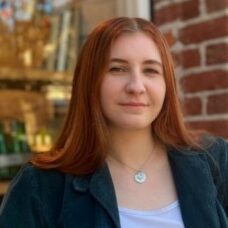This blog post is guest authored by Simone Till, program associate at the Texas Grants Resource Center at the Hogg Foundation.
October is National Disability Employment Awareness Month (NDEAM), which is a time to celebrate the contributions of employees with disabilities and to think honestly about how we can improve accessibility in our workplaces. For me, that means moving beyond checkboxes and compliance toward spaces and workplaces built with intention.
Earlier this year, I had the chance to visit Morgan’s Wonderland Multi-Assistance Center (MAC) in San Antonio, and honestly, it blew me away. Every single part of that building was designed with intention from the layout to the sensory-friendly spaces to the staff who actually get it. It is the kind of care and thoughtfulness that made me super emotional just by walking around.

Morgan’s Wonderland has already done so much: a theme park, water park, sports complex, a camp, and soon a hotel, all centered on showing the world what is possible when accessibility comes first. At Morgan’s MAC, more than 30 community organizations come together to offer coordinated medical and non-medical services for people with disabilities and their families. Families work with navigators who help ensure everything is seamless and centered around each person’s actual needs.
Walking around, I couldn’t stop thinking about my own childhood. As a deaf kid with a sister who has cerebral palsy, this kind of place would have changed everything for us. My mom used to drive her beat-up car all over town just to get us to different appointments. All that time and stress could have been saved if something like the MAC had existed.
What I also loved is how Morgan’s doesn’t just focus on physical accessibility. They think about the whole person. Living with a disability isn’t just about ramps or hearing aids. It is also about mental health and feeling like you belong. Honestly, I sometimes forget I am disabled until something reminds me: a sudden barrier, an ableist comment, or (deep sigh) someone saying that there is no way Helen Keller did all of that.
That is exactly why accessibility should go beyond the physical space. It is not just about fixing barriers when they appear, but it is about building systems that assume people have different needs from the start. This includes your physical workplace, your website, your flyers, your surveys; all of it. Creating accessible workplaces means being intentional long before someone asks for accommodation. It can be as simple as adding a note in your hiring process inviting candidates to share any access needs. It signals that accessibility is valued and expected in the workplace. It also means building a culture where people don’t have to hide parts of themselves just to fit in. When people can show up as their whole selves, everyone benefits.
Accessibility isn’t extra; it’s essential. It’s about clear communication, thoughtful design, and welcoming spaces. And really, any of us could become disabled at any point (like when Regina George gets hit by a bus in Mean Girls). We’re all aging, all changing, so accessibility isn’t for “them.” It’s for all of us.
Morgan’s Wonderland reminds me what is possible when accessibility is the starting point, not an afterthought. So, for this NDEAM, let’s be intentional about building spaces and workplaces where everyone can belong, contribute, and thrive.
Here are some additional resources on accessibility:
